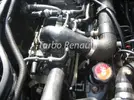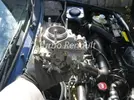Authors: Mart & Big Steve – Raider
May 2014
*Note this Carb has had the choke-flap assembly removed. If the choke-flap is still in situ, it’s fairly obvious which components of the choke assembly will need to be disconnected/removed/re-fitted whilst stripping & re-building the carb.
1. Disconnect all carb hoses, choke cable, accelerator cable, and throttle-return spring. Remove carb elbow (3 x 10mm nuts). Lift off the large o-ring & triangular retaining plate. Remove the carb from the inlet manifold (2 x 13mm nuts).


2. Remove carb top by undoing 6 x flat headed screws.

3. Carefully remove carb top taking care to remove gasket and float. You will find fuel in the float chamber that you need to empty into a jerry can.
4. Remove float pin (simply pulls out) and remove rubber gasket & discard.

5.Remove Needle valve and brass washer with a 14mm socket.

6.Remove fuel inlet nozzle with 12mm deep socket and pull out the fuel filter you will find inside as well.

7. Now that the carb top is fully stripped, clean everything with carb cleaner.
8.Onto the carb body. Remove the accelerator pump jet (Screwdriver is pointing at it) making sure you remove the seal as well (sometimes it stays in the hole).

9.The accelerator pump jet can be carefully disassembled with a pair of pliers, to remove the base. Be careful, this has small parts inside which can be lost easily!! The picture below shows the order the plunger & ball-bearing fit into the jet.

10.Now remove the enrichment block with 3 x flat headed screws. Remove the red gasket and discard.

11.Remove the 3 x long screws from this block and then the second stage enrichment cap can be removed. You will find a large spring in this unit. Again remove the black second stage diaphragm and discard.

12.Remove the 3 x short flat headed screws to remove the first stage enrichment diaphragm. Again beware there is a small spring in this part, be careful not to lose it! Remove the red triangular gasket and discard.

13.Remove the accelerator pump and lever with 4 x flat headed screws. Remove the diaphragm and beware of the small spring that sits behind the diaphragm doesn’t ping off (also note correct orientation of spring – 2nd picture below)


14.Remove the carb base with 2 x Philips screws & discard the fibre gasket that sits between the base & body. Thoroughly clean the body & base (both sides) faces, removing any traces of old gasket, and make sure both faces are straight & level, and not warped.

15. Remove the mixture screw from the carb base, making sure the screw o-ring comes out as well. Check that the mixture screw hole is nice & clean.

May 2014
*Note this Carb has had the choke-flap assembly removed. If the choke-flap is still in situ, it’s fairly obvious which components of the choke assembly will need to be disconnected/removed/re-fitted whilst stripping & re-building the carb.
1. Disconnect all carb hoses, choke cable, accelerator cable, and throttle-return spring. Remove carb elbow (3 x 10mm nuts). Lift off the large o-ring & triangular retaining plate. Remove the carb from the inlet manifold (2 x 13mm nuts).


2. Remove carb top by undoing 6 x flat headed screws.

3. Carefully remove carb top taking care to remove gasket and float. You will find fuel in the float chamber that you need to empty into a jerry can.

4. Remove float pin (simply pulls out) and remove rubber gasket & discard.

5.Remove Needle valve and brass washer with a 14mm socket.

6.Remove fuel inlet nozzle with 12mm deep socket and pull out the fuel filter you will find inside as well.

7. Now that the carb top is fully stripped, clean everything with carb cleaner.
8.Onto the carb body. Remove the accelerator pump jet (Screwdriver is pointing at it) making sure you remove the seal as well (sometimes it stays in the hole).

9.The accelerator pump jet can be carefully disassembled with a pair of pliers, to remove the base. Be careful, this has small parts inside which can be lost easily!! The picture below shows the order the plunger & ball-bearing fit into the jet.

10.Now remove the enrichment block with 3 x flat headed screws. Remove the red gasket and discard.

11.Remove the 3 x long screws from this block and then the second stage enrichment cap can be removed. You will find a large spring in this unit. Again remove the black second stage diaphragm and discard.

12.Remove the 3 x short flat headed screws to remove the first stage enrichment diaphragm. Again beware there is a small spring in this part, be careful not to lose it! Remove the red triangular gasket and discard.

13.Remove the accelerator pump and lever with 4 x flat headed screws. Remove the diaphragm and beware of the small spring that sits behind the diaphragm doesn’t ping off (also note correct orientation of spring – 2nd picture below)


14.Remove the carb base with 2 x Philips screws & discard the fibre gasket that sits between the base & body. Thoroughly clean the body & base (both sides) faces, removing any traces of old gasket, and make sure both faces are straight & level, and not warped.

15. Remove the mixture screw from the carb base, making sure the screw o-ring comes out as well. Check that the mixture screw hole is nice & clean.
































